With one week in Prague, we hit the ground running trying to see and experience as much as we could in the Golden City. There were times when I was wandering down mazes of cobbles that I had to pinch myself. Is this city even real or is it a dream? We had high expectations and Prague’s beauty and charm managed to exceed all of them. Historical, bohemian, inexpensive and fun.
This is a city that is best explored on foot. The swan-filled Vltava River divides this magical city filled with rustic bridges, ancient cathedrals and walled courtyards. Chomping on hearty goulash and drinking a pint of Pilsner, which is cheaper than water, is your reward in the evening after your legs have turned to jello. If you planned on only staying a few days that’s truly a shame. After a full week we felt reluctant to leave.
The following is a list of the Top 10 things to do in Prague:
Prague Photo Essay
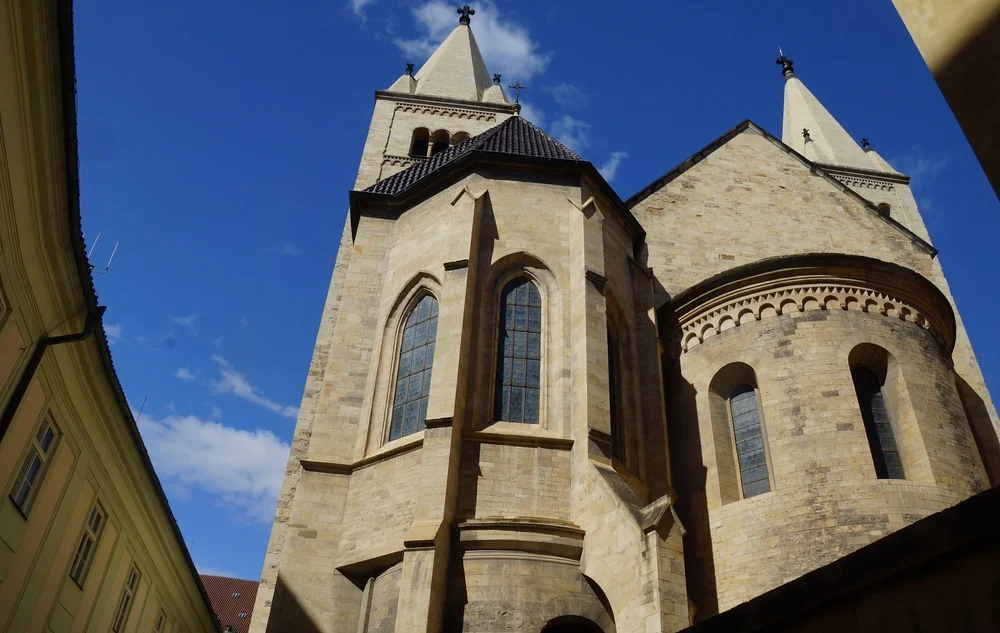
1.Prague Castle
Prague Castle is the largest ancient castle in the world and it is home to several palaces, as well as a cathedral, a basilica, and gardens. Given the entire complex is over seven times the size of a sports stadium, this 13th century charmer would take days to properly appreciate.
Some of the top highlights include visiting St. Vitus Cathedral, the Golden Lane and the tomb of St. John of Nepomuk. Although there are many activities in Prague that are free, a visit to Prague Castle is certainly worth the price of admission.
Visiting Pražský Hrad is a journey through the ages, offering a blend of Gothic, Romanesque, Baroque, and Renaissance styles. The location of Prague Castle offers some of the best views in the city. From its terraces, you can gaze out over the red-tiled roofs of Prague, the winding Vltava River, and the iconic Charles Bridge. It’s a panorama that’s especially magical at sunset.
Get There
- By Tram: Take tram numbers 22 or 23 to the Pražský hrad stop, which is right by the main entrance.
- By Metro: The closest metro station is Malostranská, followed by a short tram ride or a scenic walk.
- By Foot: For those who enjoy a walk, the route from Charles Bridge up to the castle is steep but filled with charming sights.
Visitor Tips
- Check for Events: Sometimes, parts of the castle may be closed for state events or renovations. Check the official website for the latest updates.
- Photography: Be mindful of areas where photography is not allowed, especially inside certain buildings.
- Food and Drink: There are cafes and restaurants within the castle grounds, but they can be pricey. Consider bringing your own snacks and water.
- Respect the Sites: Follow the rules and respect the historic artifacts and buildings.
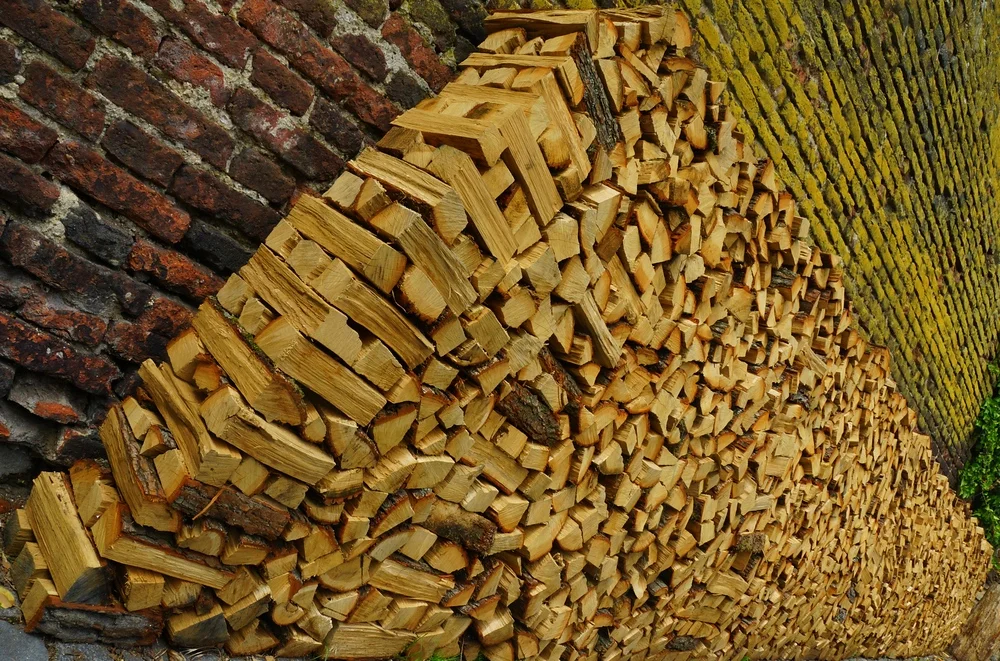
2.Novy Svet
For a quiet little escape from Prague Castle, I highly recommend wandering down Novy Svet. At one time, this cozy little neighborhood was home to servants of the Castle. With a lengthy winding cobbled street, you’ll be in the company of writers and artists who now call this neighborhood home.
Visiting Nový Svět, which translates to “New World,” is like stepping back in time. This tiny, historic street, located near Prague Castle, dates back to the 14th century. Its beautifully preserved medieval houses, many of which have quirky names and pastel colors, showcases Prague’s past.
Visiting Nový Svět feels like discovering a well-kept secret. It’s not as well-known as other tourist spots in Prague. Thus, you can explore at your own pace without the usual tourist hustle. You’ll discover cozy cafés and unique shops as you pound the cobblestone.
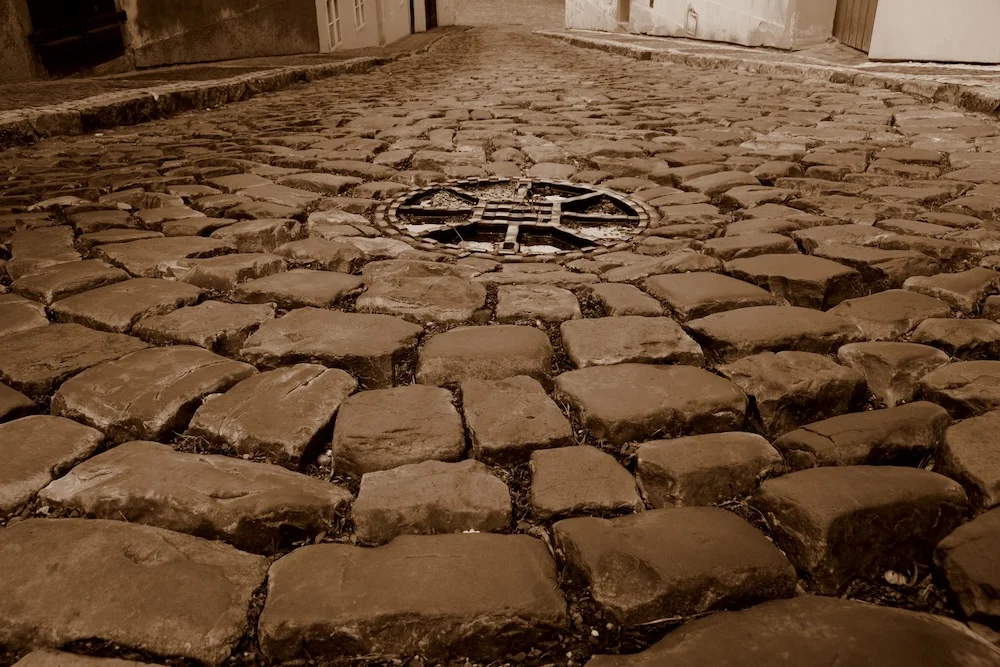
Getting There
- By Foot: Nový Svět is easily accessible on foot from Prague Castle. From the main entrance of the castle, it’s just a short walk downhill. Enjoy the scenic route and take in the views along the way.
- By Public Transport: Take tram number 22 or 23 to the Pohořelec stop. From there, it’s a pleasant walk to Nový Svět, passing by the Strahov Monastery.
Visitor Tips
- Comfortable Shoes: Wear comfortable shoes as the cobblestone streets can be uneven.
- Early Arrival: Visit early in the morning or late in the afternoon to experience the street at its most peaceful.
- Respect the Area: Be mindful that Nový Svět is a residential area. Respect the privacy of the locals and avoid making excessive noise.
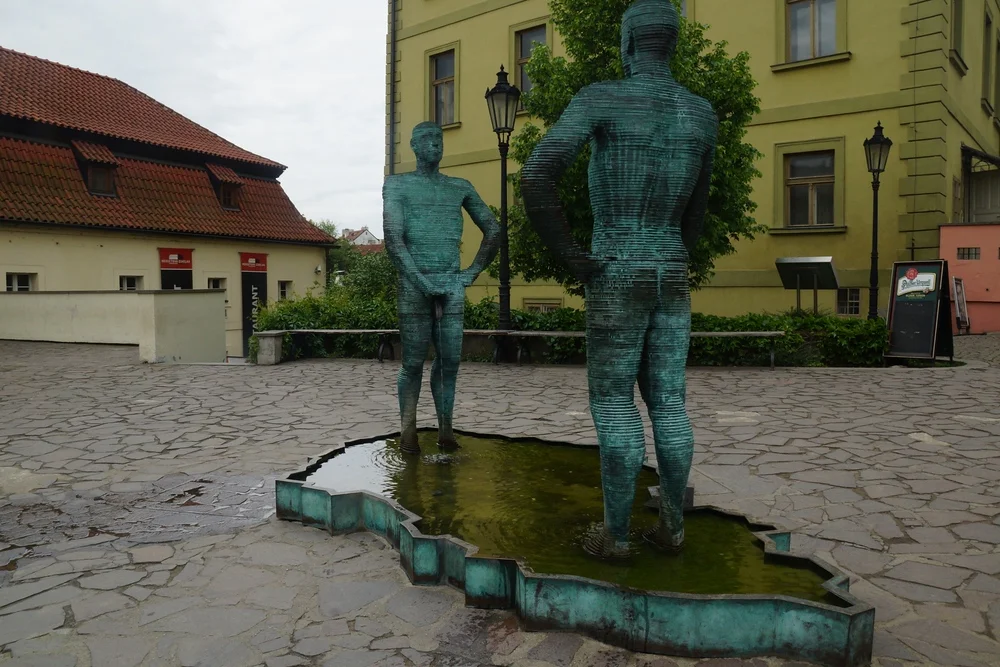
3.Kafka Museum
Franz Kafka (1883-1924) was a German language writer of novels who lived mos of his brief, anguished life in Prague. This museum is dedicated to him and his work and you’ll find some of his letters, diary entries and photographs inside. If you want to understand the mind behind “The Metamorphosis” and “The Trial,” a visit to the Kafka Museum is essential. In the courtyard you’ll notice a rather strange sculpture entitled “The Piss”. Inside you’ll find manuscripts, documents and first editions of his work displaying his often darkly paradoxical work.
The Kafka Museum isn’t your typical literary museum. It features a collection of Kafka’s original manuscripts, letters, and diaries, but what truly sets it apart is the way these items are presented. The museum uses dark, atmospheric settings, haunting soundscapes, and innovative installations to transport visitors into Kafka’s surreal world. Thus, making it a deeply immersive experience.
Kafka’s writings are often described as complex and surreal, reflecting his own troubled life. The museum provides a comprehensive look at Kafka’s personal life, his relationship with Prague, and how the city influenced his writing. You’ll learn about his family, his education, and his struggles with anxiety and illness.
One of the most striking pieces is the sculpture of two urinating men by artist David Černý, located in the museum’s courtyard. AKA the piss. It’s an example of the museum’s commitment to engaging visitors in unexpected and memorable ways.
Getting There
- Address: Cihelná 2b, 118 00 Malá Strana, Prague 1, Czech Republic.
- Public Transport: You can take tram lines 12, 20, 22, or 23 to the Malostranská stop and then walk for a few minutes.
- By Foot: If you’re exploring the city on foot, the museum is a pleasant walk from other major attractions like Charles Bridge and Prague Castle.
Visitor Tips
- Early Visit: To avoid crowds and have a more intimate experience, consider visiting the museum early in the morning.
- Take Your Time: Plan to spend a decent amount of time exploring the museum to fully appreciate the exhibits and installations.
- Explore the Area: After visiting the museum, take some time to explore the beautiful Malá Strana district. There are plenty of charming cafes, restaurants, and historic sites nearby.
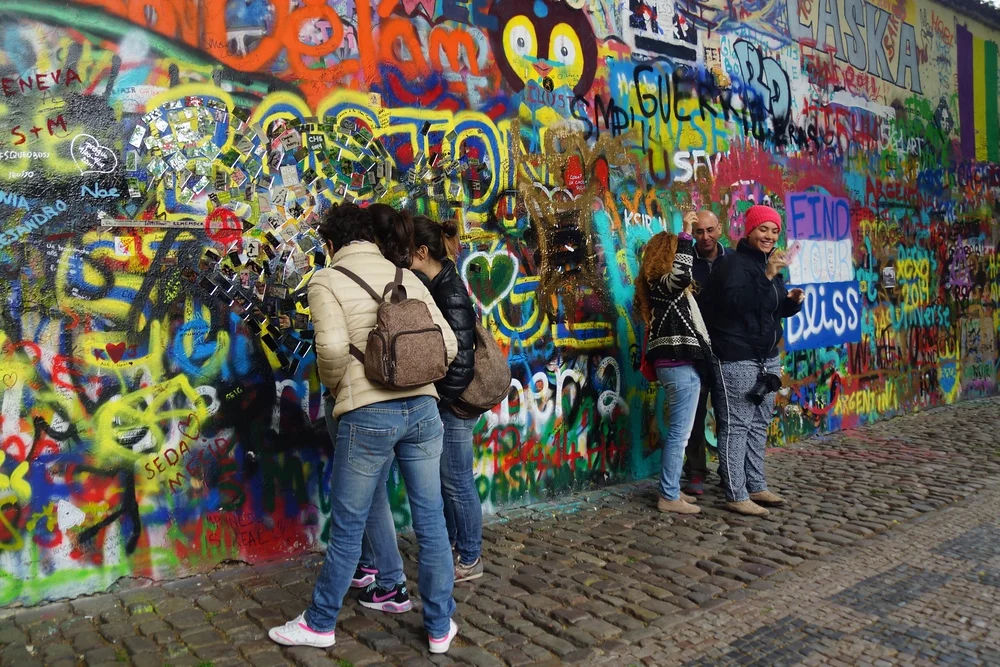
4.John Lennon Wall
Stroll along the John Lennon Wall and you’ll encounter portraits of Lennon and Yoko Ono. At one time this was just a normal wall; however, since the 1980s it has been covered by images of Lennon with Beatles song lyrics. The graffiti is always evolving, so you never know what you’ll find. The wall represents ideals associated with youth including peace and love. Admire the wall slowly or stand in front of it to take a selfie 😉
The wall became a canvas for rebellious graffiti and Beatles lyrics following John Lennon’s murder in 1980. It served as a medium for young Czechs to express their frustration with the communist regime. Today, it stands as a testament to the enduring power of art as a form of protest and expression. Each visit offers something new, as fresh layers of paint, messages, and artwork cover the previous ones. It’s a dynamic, living piece of history that you can contribute to.
Getting There
Address: Velkopřevorské náměstí, 100 00 Praha 1, Czech Republic.
Public Transport: Take tram lines 12, 20, 22, or 23 to the Malostranská stop and walk for about 10 minutes.
By Foot: If you’re near Charles Bridge, it’s a short, scenic walk across the bridge to the Malá Strana side.
Visitor Tips
- Be Respectful: While adding to the wall, remember it’s a shared space. Avoid covering up important messages or artwork.
- Stay Safe: Keep an eye on your belongings, as popular tourist spots can attract pickpockets.
- Take Your Time: Spend a while reading the messages and soaking in the atmosphere. It’s a powerful place that deserves more than just a quick visit.
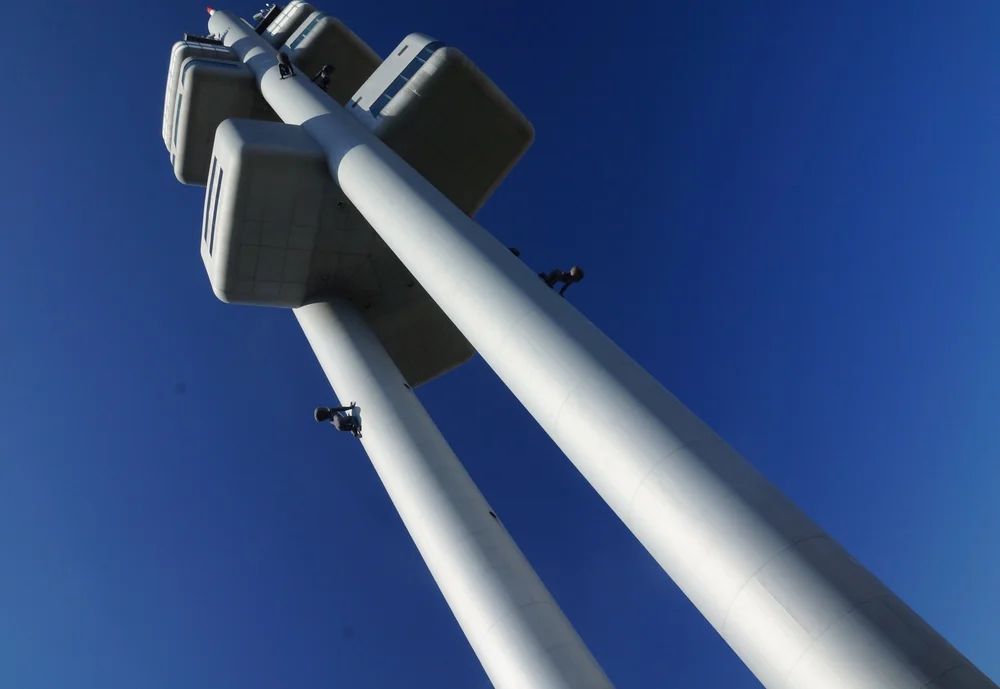
5.Prague TV Tower
One of the most distinct landmarks in the city is Prague’s TV Tower (Czech: Žižkovský vysílač). Kind of sticking out like a sore thumb, this modern tower stands tall over the city’s traditional skyline. With an unconventional design resembling a rocket, you’ll notice that there are babies crawling up and down. The local enfant terrible sculptor David Černy is also responsible for creating ‘The Piss.’
The Prague TV Tower boasts one of the most spectacular observation decks in the city. From a height of 216 meters, you get a panoramic view of Prague that’s simply unrivaled. You can see the entire cityscape, with its red rooftops, historic buildings, and the Vltava River winding through the heart of the city. On a clear day, you can even spot the distant Bohemian countryside.
This isn’t your typical TV tower. Designed in the 1980s, the Prague TV Tower is a striking example of high-tech architecture. Its futuristic design, with nine pods perched on three pillars, makes it a standout landmark. Adding to its uniqueness are the giant crawling babies sculptures by artist David Černý, which add a quirky and artistic touch to the tower.
Getting There
Address: Mahlerovy sady 1, 130 00 Praha 3-Žižkov, Czech Republic.
Public Transport: Take tram lines 5, 9, or 26 to the Jiřího z Poděbrad stop and walk for about 5 minutes.
By Foot: If you’re exploring the Žižkov district, the tower is a short walk from many local attractions.
Visitor Tips
- Best Time to Visit: For the best views, visit on a clear day. Early morning or late afternoon visits provide the best lighting for photos.
- Dining Reservations: If you plan to dine at Oblaca, make a reservation in advance to ensure a table with the best view.
- Check the Weather: For the best experience, visit on a clear day to maximize visibility.
- Arrive Early: To avoid the crowds and have a more peaceful experience, try to visit early in the morning.
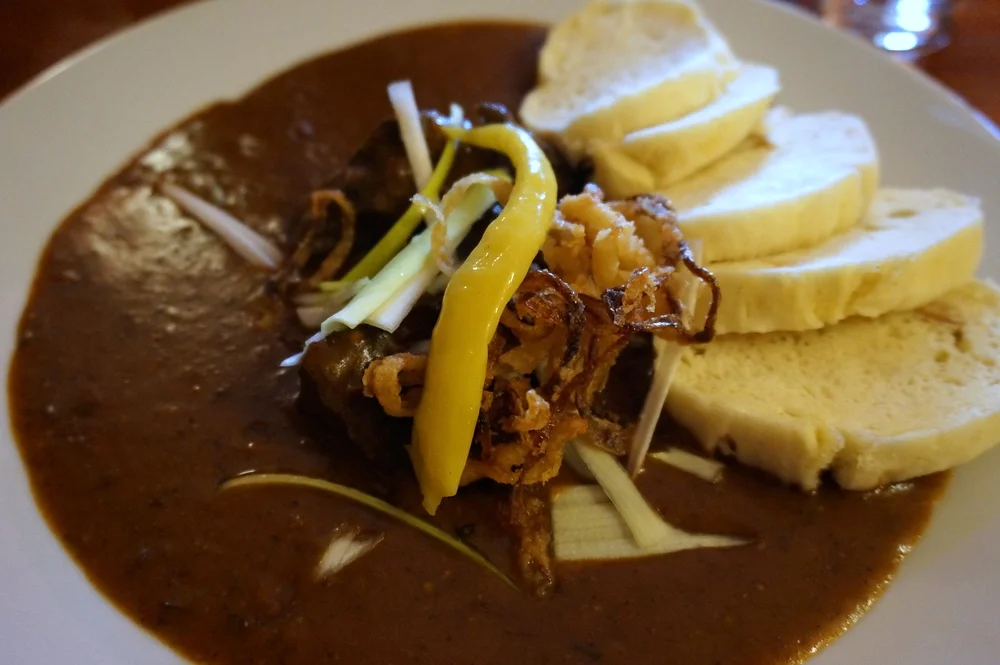
6.Czech Food: Goulash
Up next we have a heaping plate of Goulash. Goulash is actually Hungarian but the Czech Republic does have its own variety. What differs between the two is that the Hungarian is usually served with meat, noodles and vegetables and the one from the Czech Republic only has meat. I this at least once a day – while living in Prague – and it is the kind of hearty stick to your ribs meal that goes very well with a Pilsner beer.
When in Prague, indulging in a hearty bowl of goulash is an absolute must. It’s a thick, savory stew made from slow-cooked beef, onions, garlic, and a blend of spices like paprika, caraway seeds, and marjoram. The long cooking process ensures the meat is tender and the flavors are deeply infused. It results in a dish that’s rich, hearty, and incredibly satisfying.
Goulash can be enjoyed in various ways. While the traditional beef goulash is a favorite, you can also find versions with pork, venison, or even vegetarian options. It’s typically served with bread dumplings (knedlíky), but it can also come with potatoes or fresh bread. One of the great things about goulash is that it’s both affordable and filling. You get a generous portion of hearty, delicious food without blowing up your wallet.
Where to Try Goulash
- Traditional Restaurants: For an authentic experience, head to traditional Czech restaurants like Lokál, U Fleků, or U Medvídků. These spots are known for their excellent goulash and classic Czech ambiance.
- Pubs and Beer Halls: Places like Pivovarský dům and U Kalicha offer hearty goulash paired with excellent Czech beer. It’s a fantastic way to enjoy the dish in a lively, local setting.
- Street Food Markets: During food festivals or at farmers’ markets, you might find food stalls offering delicious goulash. This is a great way to try the dish in a casual, bustling environment.
Visitor Tips
- Ask for Recommendations: Locals often know the best spots for goulash, so don’t hesitate to ask for recommendations.
- Try Different Variations: While the classic beef goulash is a must, don’t shy away from trying pork or venison goulash for a different twist.
- Enjoy with Dumplings: Traditional bread dumplings (knedlíky) are the perfect accompaniment to goulash. Make sure to dip them in the sauce for the full experience.
- Take Your Time: Goulash is a dish meant to be savored. Take your time to enjoy the rich, complex flavors and the cozy atmosphere of the place you’re dining at.
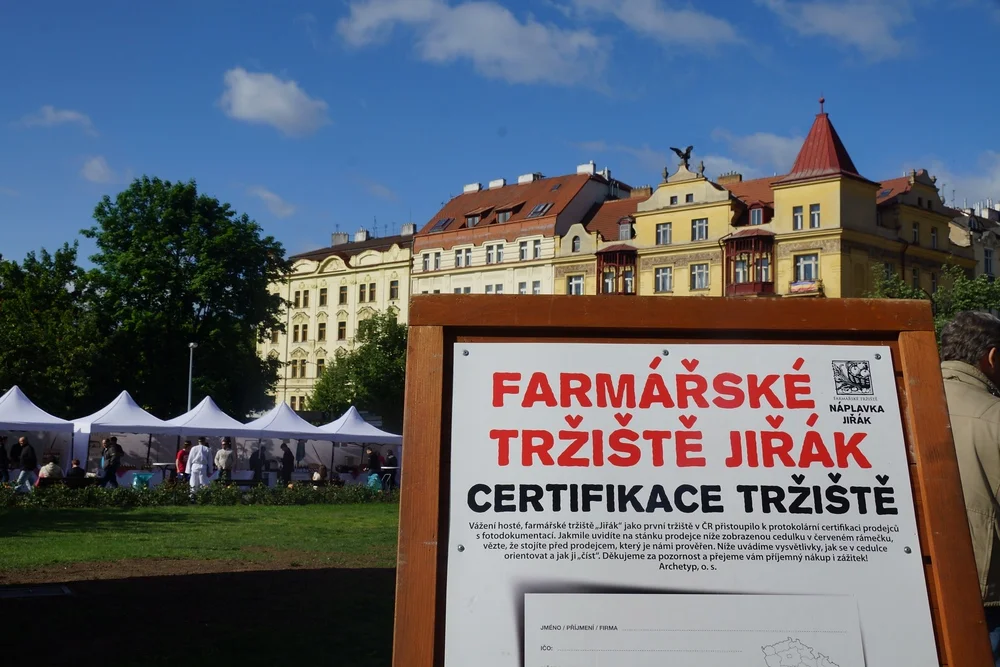
7.Saturday Market – Farmarske Trziste Jirak
You can’t visit Prague without checking out a local Farmer’s Market. We just happened to stumble across Farmarske Trziste Jirak, where we were be able to pick up some pastries, cakes, street food and organic products. It was the perfect place for a great leisurely brunch. We ended up feasting on a Balkan burger while snacking on pastries for dessert while people watching.
Visiting the Saturday Market at Farmářské Tržiště Jiřák is a quintessential Prague experience that immerses you in the local culture.You’ll find an array of fresh, locally sourced fruits and vegetables, meats, cheeses, and baked goods. Beyond fresh produce, the market is also home to a variety of artisanal products. From homemade jams and honey to handcrafted soaps and candles, the market showcases the talents of local artisans. It’s a perfect place to pick up unique souvenirs or gifts.
One of the highlights of the Saturday Market is the mouth-watering street food. You can sample traditional Czech dishes like trdelník (a sweet pastry), langoš (fried dough with garlic and cheese), and sausages, all freshly prepared on-site. There are also international food stalls, ensuring a diverse culinary experience.
Getting There
- Metro: Take the Metro Line A to Jiřího z Poděbrad station. The market is just a short walk from the station.
- Tram: Several tram lines stop nearby, including lines 11, 13, and 17. Check the tram schedules for the most convenient route.
- Walking: If you’re staying in the nearby neighborhoods, walking to the market is a pleasant option. Enjoy the local sights along the way.
- Bike: Prague is a bike-friendly city, and you can easily ride to the market. There are bike racks available near the market area.
Visitor Tips
- Early Arrival: Visit early to enjoy a more relaxed atmosphere and get the freshest picks.
- Try Local Specialties: Don’t miss out on trying traditional Czech foods like trdelník and langoš.
- Chat with Vendors: Engage with the vendors to learn more about their products and get recommendations.
- Enjoy the Music: Take a moment to listen to the live music performances that often accompany the market.
- Eco-Friendly: Bring your own bags and containers to reduce waste.
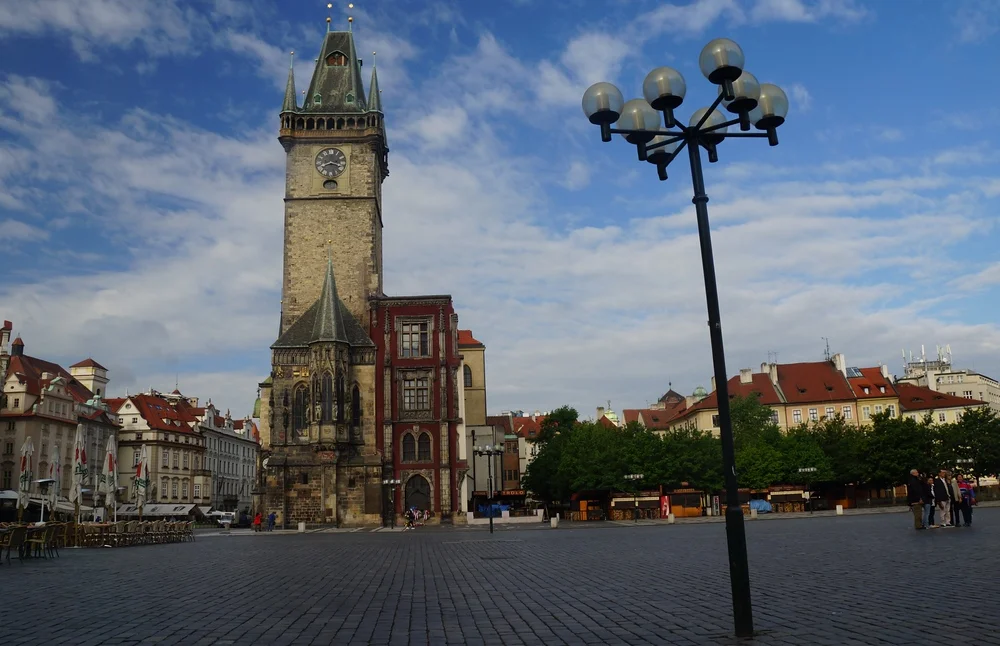
8.Prague’s Old Town Square
Prague’s Old Town is a place you can’t miss. The elegant buildings in varying pastels are a place that you’ll want to photograph. If you come early in the morning there is hardly anyone, which is in stark contrast to the afternoon when it is a sea of humans.
The square is home to some of Prague’s most significant and stunning buildings. The Gothic spires of the Church of Our Lady before Týn dominate the skyline, while the Old Town Hall boasts the world-famous Astronomical Clock. Each structure tells a tale of different eras and architectural styles.
The Old Town Square is always buzzing with activity. Street performers, musicians, and artists fill the air with lively entertainment. Seasonal markets, especially the Christmas and Easter markets, transform the square into a festive wonderland with beautifully decorated stalls offering traditional crafts, food, and drinks.
Getting There
By Metro: Take Line A to Staroměstská station. From there, it’s a short walk to the square.
By Tram: Tram lines 2, 17, and 18 stop at Staroměstská. Walk a few minutes to reach the square.
By Foot: If you’re staying in the Old Town or nearby areas, the square is easily accessible by walking. Enjoy the charming streets leading up to this historic spot.
Visitor Tips
- Early Arrival: Arrive early in the morning to avoid crowds and enjoy a quieter experience.
- Stay Aware: Keep an eye on your belongings, as the square can get very crowded.
- Check the Schedule: Look up any special events or markets taking place during your visit to enhance your experience.
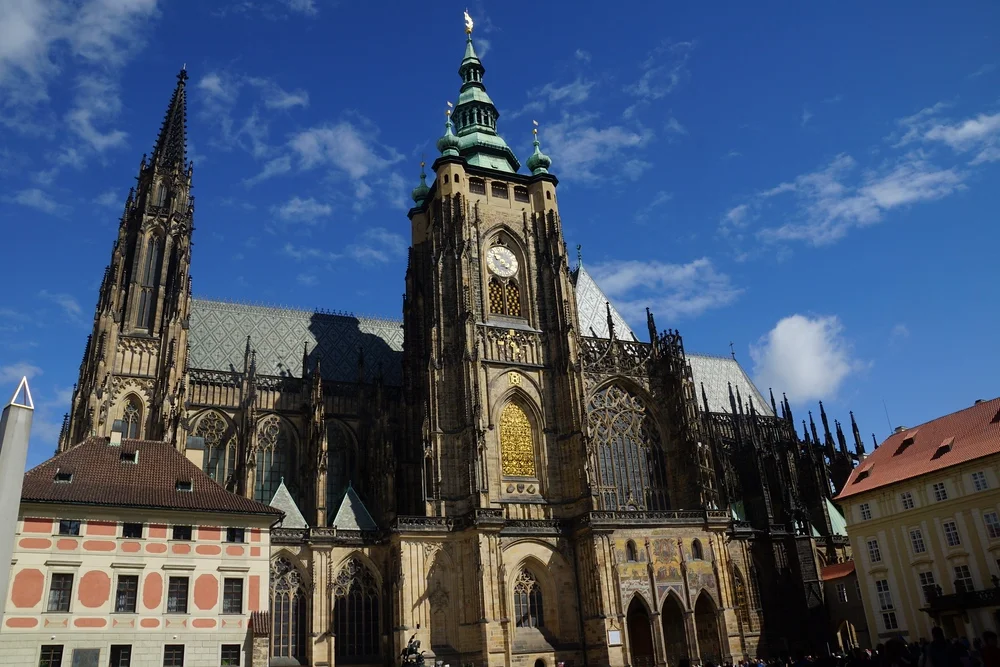
9.Saint Vitus Gothic Cathedral
Saint Vitus (Czech: Katedrála svatého Víta) is a Gothic cathedral located within the walls of Prague Castle. Inside you’ll be able to admire beautiful stained glass windows designed in the art nouveau style. The cathedral houses the tombs of many Bohemian kings and Holy Roman Emperors as main feature of the Prague Castle complex.
The first thing that strikes you about Saint Vitus Cathedral is its sheer size and grandeur. The towering spires, intricate stone carvings, and impressive flying buttresses are awe-inspiring. The detailed facade, with its statues and gargoyles, is a marvel of Gothic architecture.
Inside, the cathedral is just as breathtaking. The high vaulted ceilings, expansive nave, and magnificent stained glass windows create a sense of awe and reverence. The windows, particularly the Rose Window, are stunning works of art that flood the interior with colorful light.
For those willing to climb the 287 steps to the top of the Great South Tower, the reward is a panoramic view of Prague that is simply unmatched. From this vantage point, you can see the red rooftops, winding Vltava River, and the sprawling cityscape.
Getting There
- By Metro: Take Line A to Malostranská station. From there, it’s a short walk up to Prague Castle.
- By Tram: Tram lines 22 and 23 stop at Pražský hrad. The cathedral is within the castle complex.
- By Foot: If you’re staying in the Old Town or nearby areas, you can walk to the castle and enjoy the scenic route.
Visitor Tips
- Early Arrival: Visit early to avoid crowds, especially during peak tourist seasons.
- Dress Appropriately: As a place of worship, ensure you dress modestly. Shoulders and knees should be covered.
- Photography: Check the rules on photography. Flash photography might be prohibited inside the cathedral.
- Respect the Space: Maintain a respectful demeanor, as the cathedral is an active place of worship.
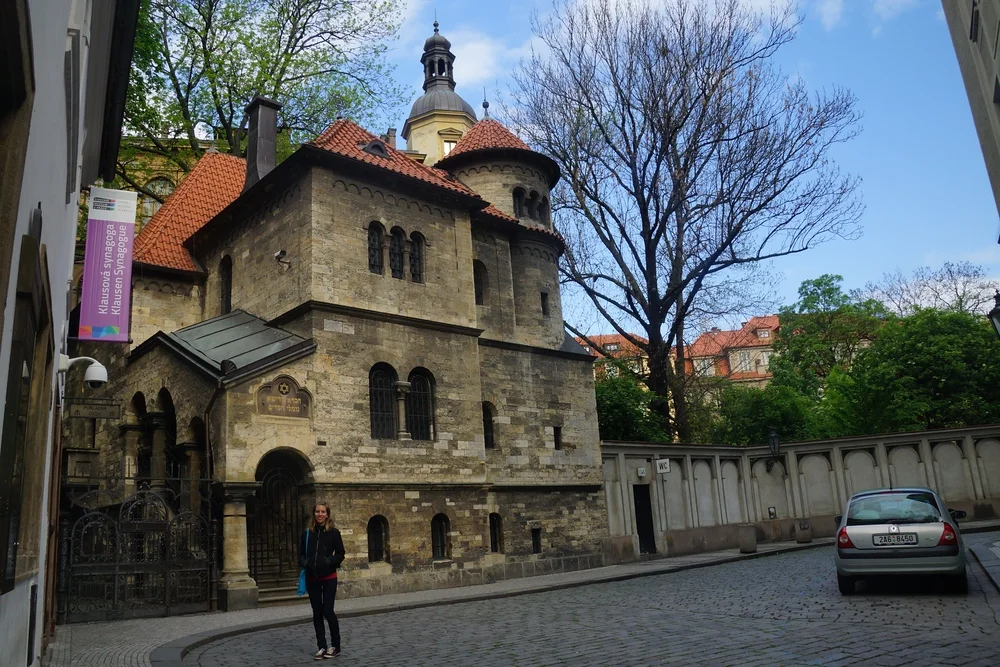
10.Jewish Quarter
If you keep going north from the Old Town Square you’ll find yourself in the Jewish Quarter of Josfov (German: Josefstadt). Completely surrounded by the Old Town, this district was preserved during Nazi German occupation with the intention of being made into a museum of an extinct race. Today, you’ll be able to many architecturally stunning synagogues.
The Jewish Quarter is one of the oldest and most well-preserved Jewish districts in Europe. Its history dates back to the 10th century, and the area has witnessed significant events that have shaped the Jewish community in Prague.
The district is home to some of Prague’s most stunning architectural works. The Old-New Synagogue, built in the 13th century, is the oldest active synagogue in Europe and a masterpiece of Gothic architecture. The Spanish Synagogue, with its Moorish Revival style, and the Pinkas Synagogue, which now serves as a memorial to Holocaust victims, are equally impressive.
A visit to the Jewish Quarter is incredibly educational. The synagogues, museum, and cemetery offer detailed exhibitions and displays that provide a thorough understanding of Jewish history and culture. It’s a chance to learn about the resilience and contributions of the Jewish community in Prague.
Getting There
- By Metro: Take Line A to Staroměstská station. The Jewish Quarter is a short walk from there.
- By Tram: Tram lines 17 and 18 stop at Právnická fakulta, which is close to the Jewish Quarter.
- By Foot: From Old Town Square, it’s just a few minutes’ walk to reach the district.
Visitor Tips
Respect the Sites: Remember that many sites in the Jewish Quarter are places of worship and remembrance. Maintain a respectful demeanor.
Photography Rules: Be mindful of photography restrictions, especially in the synagogues and cemetery.
Early Arrival: To avoid crowds, try to visit early in the morning.
And that sums up our visit to Prague! Our 1 week in the city left us bedazzled and it’s a place that we’d be happy to revisit again in the near future.
What are some of your favorite things to do in the city? Please let us know in the comment section below.
